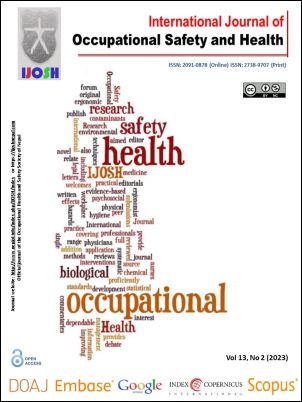Effect of Lifting Weight, Height and Asymmetry on Biomechanical Loading during Manual Lifting
DOI:
https://doi.org/10.3126/ijosh.v13i2.43180Keywords:
Manual Material Handling, Asymmetric posture, Loading Rate, Workload AssessmentAbstract
Introduction: In India, physical manual activities in asymmetrical postures overtax the human musculoskeletal system, which may exceed workers' physical limitations. Thus the purpose of this study was to examine the physical stresses experienced by the subject, based on subjective and biomechanical loading estimates while lifting weights to various heights, in an asymmetric direction and propose the safe limit for manual lifting.
Methods: A laboratory experiment was conducted utilizing twelve male subjects in the age group of 20 to 25 years who lifted 5 different weights between 10 to 20 kg from below the knee to various lifting heights (below the knee to ear level). The lifting task was performed in three asymmetric angles (45, 90, and 135-degree) using free-style lifting techniques. An ANOVA technique was used to analyze the influence of three parameters (Lifting weight, lifting height and asymmetric angle) on two responses; subjective estimates and biomechanical loading. The subjective estimate was obtained using workload assessment by body discomfort chart. The biomechanical loading (loading rate) was estimated from ground reaction force data, obtained from the force plate.
Results: Both the responses; subjective estimates and biomechanical loading followed a consistent pattern in predicting physical stress. The result revealed that lifting weights with higher destination heights and asymmetry angles increased the physiological workload and discomfort. Experiments have shown that the loading rate is reduced by 8 to 10% for each increase in the 45-degree angle of asymmetry.
Conclusion: In general, safe lifting of 15 kg weight up to ear level and 15 kg weight up to shoulder level are recommended for 45- and 90-degree asymmetry respectively to prevent any chronic injuries. A maximum of 12.5 kg lifting weight up to shoulder level is also proposed.
Downloads
Downloads
Published
How to Cite
Issue
Section
License
Copyright (c) 2023 Anurag Vijaywargiya, Mahesh K. Bhiwapurkar, A. Thirugnanam

This work is licensed under a Creative Commons Attribution-NonCommercial 4.0 International License.
This license enables reusers to distribute, remix, adapt, and build upon the material in any medium or format for noncommercial purposes only, and only so long as attribution is given to the creator.





